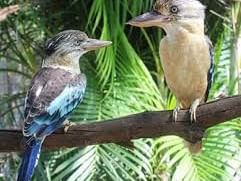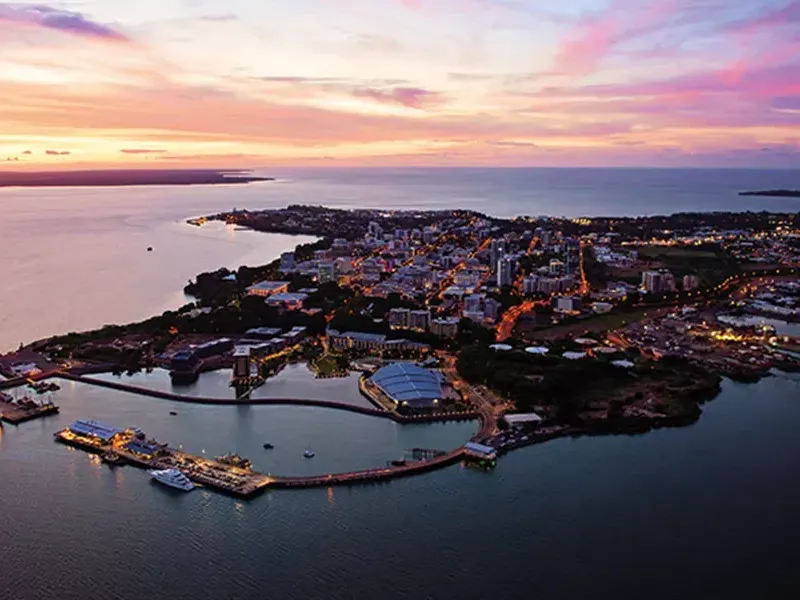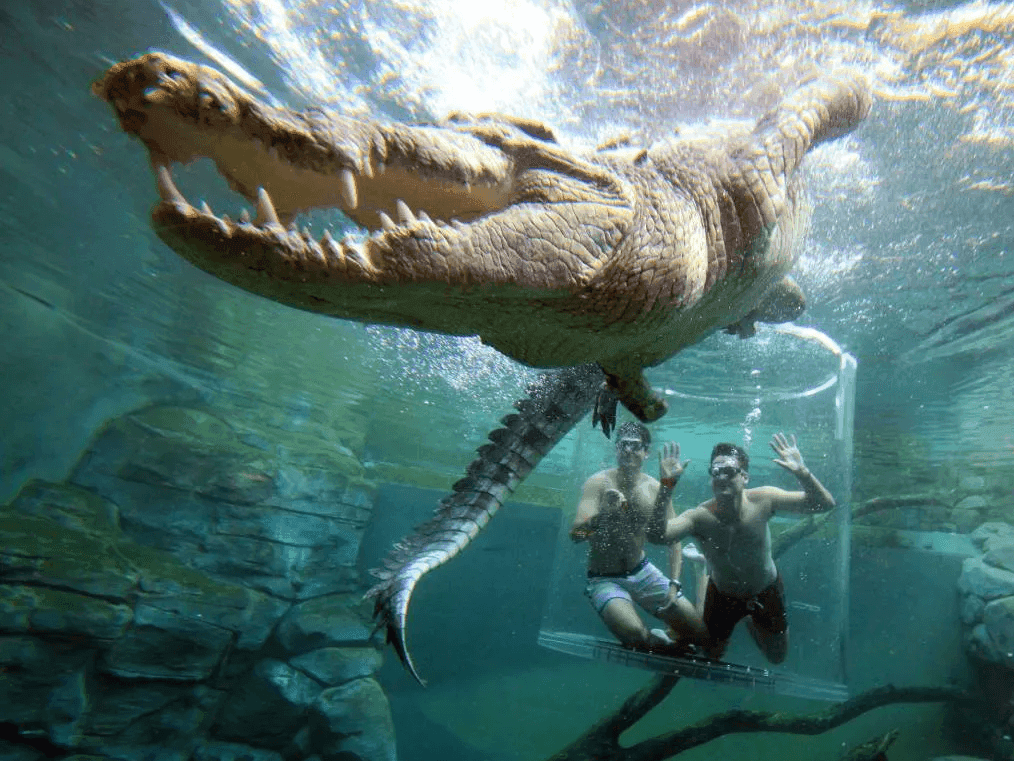
1. Birdlife in Darwin
Darwin is a hotspot for birdwatching, with more than 230 species of birds calling the region home. The city is located along the East Asian-Australasian Flyway, a critical migration route for many species. You’ll find a mix of tropical birds, seabirds, and wetland species in and around the city.
Key places to spot birds include:
- East Point Reserve: This area is known for its great birdwatching opportunities, especially for species like the Great Egret, Black-winged Stilt, and the majestic White-bellied Sea Eagle.
- Charles Darwin National Park: A haven for birdlife, with species such as the Rainbow Bee-eater, Green Pygmy-Goose, and a variety of waders frequently spotted.
- Howard Springs Nature Reserve: A great spot to see the iconic Northern Rosella, as well as the elusive Gouldian Finch and other native species.
2. Mammals of the Top End
While the mammals of Darwin might not be as abundant as some other regions in Australia, the city and surrounding areas do provide home to a number of unique species. One of the most iconic mammals in the area is the Northern Hairy-nosed Wombat, one of the rarest mammals in the world, found only in a few protected areas.
You might also spot:
- Agile Wallabies grazing near the bushland outskirts of Darwin.
- Flying Foxes (fruit bats), which are often seen roosting in trees during the day and taking to the skies at night.
- Short-eared Rock Wallabies in the rugged escarpments surrounding Darwin.
3. Reptiles and Amphibians
Darwin is also a hotspot for reptiles, with the warmer climate supporting many species of lizards, snakes, and even crocodiles.
- Saltwater Crocodiles are perhaps the most famous residents. These apex predators can be found in various locations such as Crocodylus Park or on a wildlife cruise along the Adelaide River. It’s a thrilling experience to witness these ancient reptiles in their natural habitat.
- Frilled Neck Lizards are another iconic species found in the Northern Territory. Their dramatic frill and defensive display are a must-see when they’re startled or threatened.
- Green Tree Frogs and Yellow-spotted Monitor Lizards are commonly seen near the wetlands or along hiking trails.
4. Marine Life
Given its proximity to the coast, Darwin is an excellent destination for those looking to explore marine life. The waters around Darwin are teeming with vibrant marine ecosystems, perfect for snorkeling or diving.
- Sea Turtles can be seen nesting on the region's beaches during the nesting season. The nearby Kakadu National Park is home to many turtle species.
- Dugongs (sea cows), which are related to manatees, are often spotted in the coastal waters.
- Mangrove Ecosystems support an incredible diversity of marine life, including mud crabs, rays, and even the elusive saltwater crocodile.
5. Aboriginal Cultural Connection to Wildlife
The indigenous people of the Northern Territory have a deep and meaningful connection to the land and its wildlife. Their stories, often passed down through generations, speak of the sacredness of animals and the interdependence of all living things. A visit to Darwin offers the chance to learn about these cultural connections, such as through guided tours or visits to indigenous art galleries that feature local wildlife motifs.
6. Ecotourism and Conservation Efforts
Darwin is not only about observing wildlife; it’s also a place where conservation efforts are actively happening. Several initiatives in the region aim to protect endangered species, such as the Northern Hairy-nosed Wombat, Bilbies, and Saltwater Crocodiles. Visitors can get involved in these conservation projects by visiting wildlife sanctuaries like the Trower Park Wildlife Reserve or taking eco-tours that highlight the importance of preserving the unique flora and fauna.
7. Best Wildlife Experiences in Darwin
For those wanting to get up close to Darwin’s wildlife, a few must-do experiences include:
- A guided boat cruise on the Adelaide River to see crocodiles in the wild.
- A trip to the Territory Wildlife Park or Crocodylus Park, where you can observe a wide range of animals in their natural habitats.
- Bushwalks in Kakadu and Litchfield National Parks, where you’ll encounter a variety of wildlife and learn about the park’s diverse ecosystems.
8. Wildlife Watching Beyond the City
While Darwin itself offers ample opportunities to observe wildlife, a short drive or boat ride can take you to even more incredible areas where nature truly thrives.
-
The Mary River Wetlands: Just a short drive from Darwin, the Mary River Wetlands are a must-visit destination for anyone keen on birdwatching and spotting other animals. Known for its massive population of saltwater and freshwater crocodiles, these wetlands are also home to wallabies, wild pigs, and a wide range of bird species, including magpie geese and whistling kites. The region is also an excellent place to enjoy a peaceful boat tour where you can see animals in their natural habitat from a safe distance.
-
Kakadu National Park: A UNESCO World Heritage Site located about 3 hours from Darwin, Kakadu is home to more than 280 species of birds, 75 species of mammals, and hundreds of reptiles. The park features a stunning variety of landscapes, from wetlands and rainforests to rocky escarpments. You can spot the endangered Gouldian Finch, as well as large colonies of flying foxes in the twilight hours. Kakadu is also the ideal place to explore Indigenous rock art that has been preserved for thousands of years, giving a deeper context to the area’s wildlife and cultural significance.
-
Litchfield National Park: Another gem located not far from Darwin, Litchfield is famed for its waterfalls and crystal-clear swimming holes, but it’s also home to an impressive array of wildlife. The park’s diverse habitats host species such as the Agile Wallaby, Northern Brown Bandicoot, and various frogs and reptiles. The easy-to-access walking trails make it simple to immerse yourself in the environment, and keep an eye out for the mysterious freshwater crocodiles that inhabit the park's streams and waterholes.
9. Darwin’s Nightlife—Beyond the City Lights
Darwin has a tropical climate that encourages many creatures to be more active in the cooler evening hours. The city comes alive with a different set of critters when the sun sets, offering even more chances to spot wildlife.
-
Nocturnal Animals: Many of the mammals and reptiles in Darwin, such as bandicoots, sugar gliders, and geckos, are nocturnal, meaning they’re more active after dark. If you’re staying in one of the nearby national parks or reserves, take a nighttime wildlife tour to catch a glimpse of these fascinating creatures. The Northern Ghost Bat, for example, emerges at dusk and is an elusive species that can be seen in certain areas around Darwin.
-
Night Cruises on the Adelaide River: An adventurous way to witness wildlife after hours is by taking a night cruise on the Adelaide River. As you glide through the water, you can spot crocs hunting, as well as other nocturnal animals emerging from the shadows. Many companies offer these exciting tours, where you can hear about local wildlife and conservation efforts from expert guides.
10. The Fascinating Insects of the Top End
While the large mammals and reptiles often steal the spotlight, the insect world in Darwin is nothing short of extraordinary. Due to its tropical climate, Darwin is home to a dazzling array of colorful and unique insects.
-
Termite Mounds: These iconic mounds are found throughout the Top End, with the magnetic termite mound being one of the most famous. These mounds are so precisely aligned with the earth’s magnetic field that they have become a fascinating subject of study. You can visit Litchfield National Park to see these architectural marvels up close.
-
Giant Dragonflies and Butterflies: In the wetter months, you'll see a proliferation of stunning dragonflies flitting above the wetlands. Darwin also has a rich diversity of butterflies, with species like the Magpie Butterfly and the Juno Butterfly often seen in local gardens.
-
The Green Tree Ants: These curious insects are fascinating to watch. Known for their teamwork and ability to create intricate nests in trees, they are also a key part of the food chain, feeding on the leaves of native plants and occasionally becoming a snack for local birds.
11. Cultural and Ecological Tours: A Deeper Connection
For those interested in gaining a deeper understanding of both the natural world and its cultural significance, Darwin offers several eco-tours that merge wildlife with Indigenous knowledge.
-
Indigenous Wildlife Tours: Indigenous guides from the Larrakia people offer wildlife tours that incorporate the cultural knowledge of the land’s traditional custodians. These tours often include stories of how the local wildlife is intertwined with ancient myths and how Indigenous people have long managed the land and its creatures sustainably.
-
Wildlife Conservation Experiences: If you're passionate about conservation, several programs in Darwin allow you to actively participate in protecting local wildlife. Whether it's volunteering with crocodile research teams, participating in tree-planting projects, or learning about sustainable practices for managing marine life, there are many ways to get involved in preserving the natural beauty of the region.
12. The Challenges Facing Wildlife in Darwin
While Darwin’s wildlife is diverse and abundant, it faces many challenges. The Northern Territory is a dynamic environment, and its wildlife is constantly adapting to changes such as habitat loss, invasive species, and climate change.
-
Invasive Species: Species such as the cane toad, wild pigs, and buffalos threaten the balance of the local ecosystems. Cane toads, in particular, pose a risk to native predators, such as quolls and reptiles, who are poisoned when they try to eat the toads.
-
Climate Change: The increasing frequency of extreme weather events, such as cyclones and droughts, can severely impact habitats for wildlife, especially for species that rely on seasonal weather patterns. Rising sea levels also threaten the coastal ecosystems and mangrove forests that many animals depend on.
13. Final Words: A Wildlife Paradise Like No Other
Darwin’s unique mix of ecosystems, vibrant wildlife, and rich cultural heritage makes it an unparalleled destination for nature lovers. From crocodile-watching adventures to serene birdwatching moments in tranquil reserves, the opportunities to encounter wildlife in Darwin are endless. As you explore the natural wonders of this tropical paradise, you’ll quickly see that every trail, waterway, and mangrove holds the promise of discovery—of nature’s unspoiled beauty and the creatures that inhabit it. Whether you’re visiting for a few days or longer, Darwin offers an immersive, exciting, and authentic Australian wildlife experience that’s hard to find anywhere else.
While exploring Darwin's rich and vibrant wildlife the best place to start your journey is with us at the Poinciana




